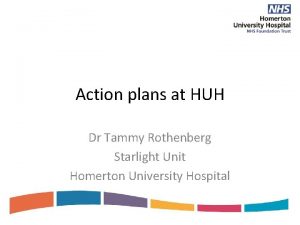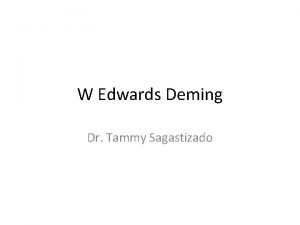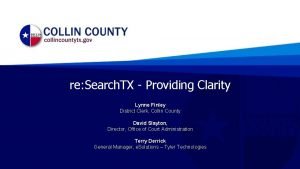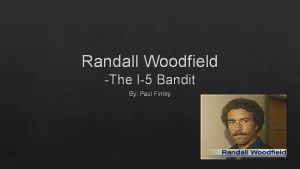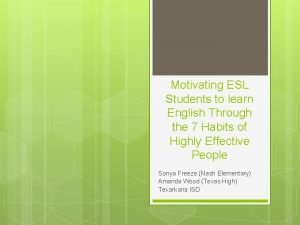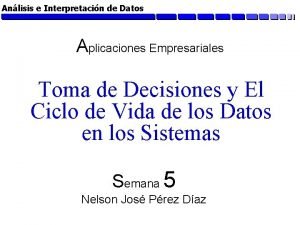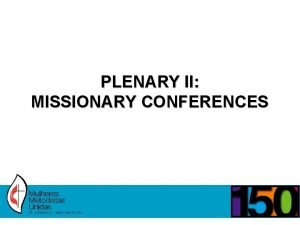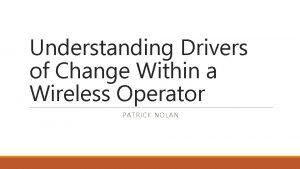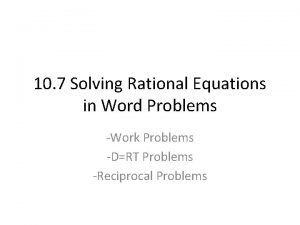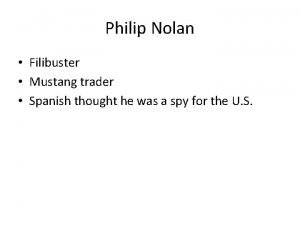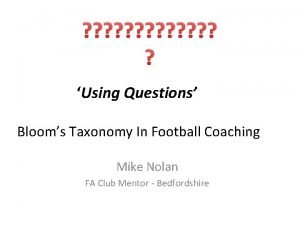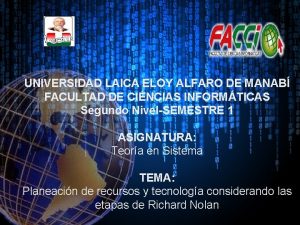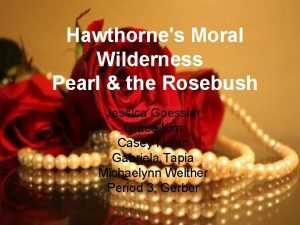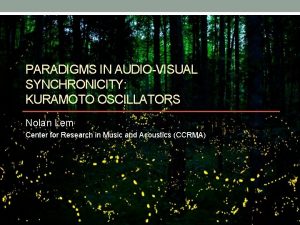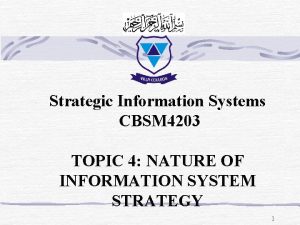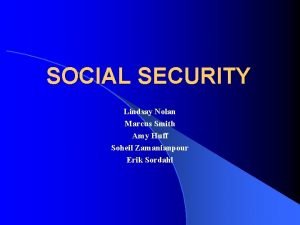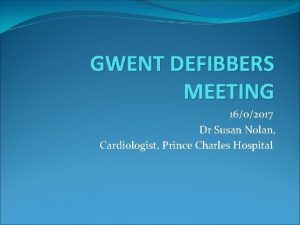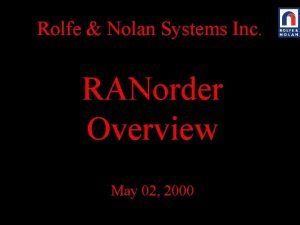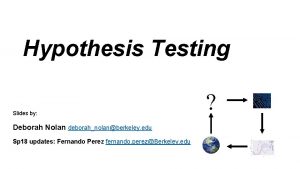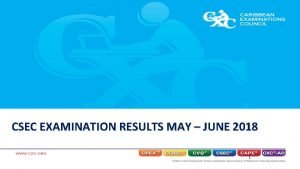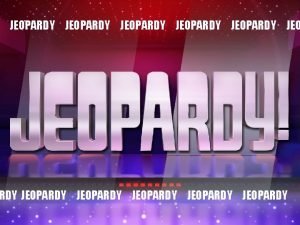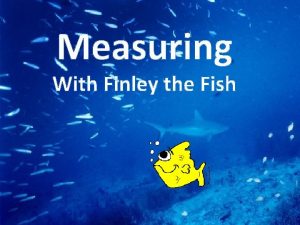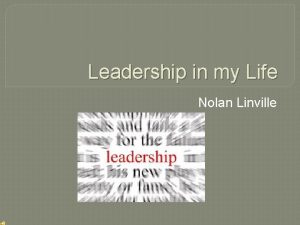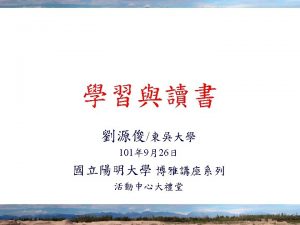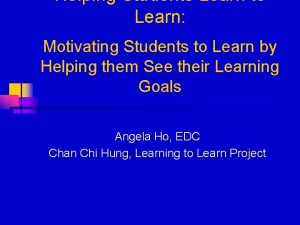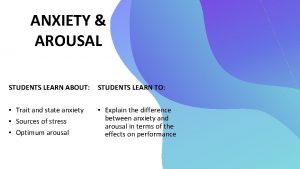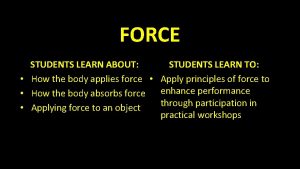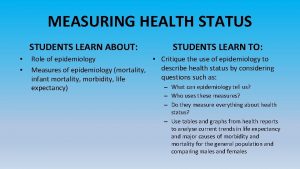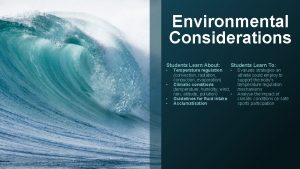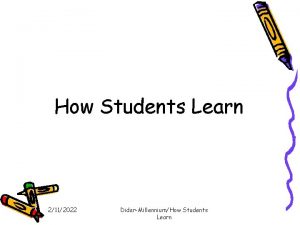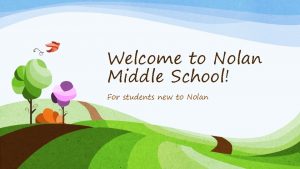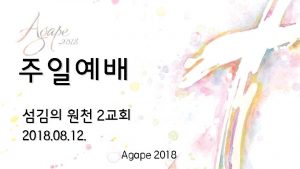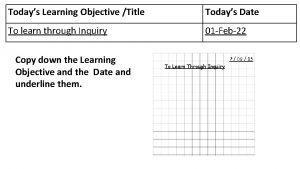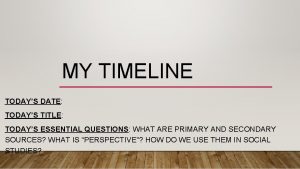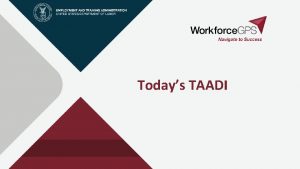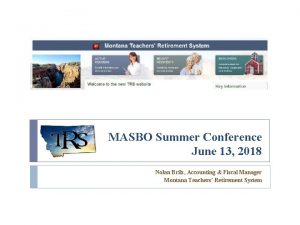Nolan Finley May 31 2018 Todays students learn



































- Slides: 35


Nolan Finley, May 31, 2018 Today’s students learn very much the way their parents and grandparents did –sitting in rows in front of a teacher who delivers subject content until a bell rings and they shuffle to the next class. That worked in an economy that needed factory and office workers equipped to do rote jobs…. . But that world no longer exists NOTE: French schools are largely the same! 2

Or as Dintersmith (2018) puts it in his poplar education book…. . • We are teaching what is easy to test. BUT, what’s easy to test, is not always what’s important to learn. {paraphrasing from page 64} 3

Some interesting facts • We are in the knowledge age. In 2013 Schilling estimated that information was doubling every 12 months now, they project it doubles every 12 hours. • Current thinking suggests that integrating information and innovation is key – emphasizing critical thinking, creativity and curiosity. 3/1/2021 4

Are we preparing children for the workplace of tomorrow (or even of today)? NO – our current model of education (and parenting) is founded on the idea that mastery of content is the key to success in life, but what counts as success has undergone a revolution in a Google and Wiki world where facts are at our fingertips. The Traditional Way Preparing Children in just: Reading Writing Math The 21 st Century Way Supporting Children to include but go beyond content to be: Happy, healthy, thinking, caring, and social so they become collaborative, creative, competent, and responsible world citizens tomorrow Echoing Director General of UNESCO Azoulay 5

Finnish scientist, Pasi Sahlberg reminds us our laser focus on a narrow view of success has NOT produced results and that the equity of our education system is what matters. Note the French 2012 PISA scores. It changed little in the 2015 tests. The OECD PISA 2015 results are now in. Even if France’s performance hasn’t deteriorated since the last series in 2012, it has not improved much compared to previous rounds either. France’s results for science and mathematics are around the OECD average, while reading comprehension is slightly above average… 6

At the Brookings Institution, we are seeding a movement towards Skills for a Changing World – an effort to broaden the way we look at educational outcomes and the way we define success. My recent book: Becoming Brilliant: What science tells us about raising successful children is one example of the wider movement. 3/1/2021 7

In our book, we distill from research in science of learning, the business community, and education to argue that a narrow focus only on mastery of content will NOT allow us to achieve success for our time The 6 Cs Science of learning Collaboration Communication Content Critical thinking Creative innovation Confidence This process allowed us to suggest 6 Cs that could support learning in an evidence-based way 9/22/17

We chose this set because • These skills or competencies are grounded in the science of learning • They are all malleable • They are all measurable (some to a greater degree than others) Care et al. , 2015 3/1/2021 9

I present this today as a framework 3/1/2021 10

And we argue that the key to success is captured in one word: Breadth of Context Breadth of Skills Breadth of Ages 9/22/17 11

How do we achieve success? 21 st century education requires a breadth of skills Each of which is: - Grounded in science - Inter-related - Malleable - Measurable Collaboration Communication Content Critical Thinking Creative Innovation 9/22/17 Confidence 12

What are the skills needed for Success? The 6 C’s and the science behind them 9/22/17 13

Collaboration Humans are social beings at their very core. As Kuhl noted, we have a “socially gated brain” such that we learn by forming strong human relationships. This is particularly true for younger children. This human interaction is not only key for learning (at home and in classrooms) but also forming communities, having a sense of belonging. Some of the research in this area is relevant to issues of how to best use technology at home, in classrooms and in the construction of MOOCs Bodrova & Leong (2007), Tools of the Mind Yalda et al. , (2014) Computers in Human Behavior Mc. Clelland (2016) Stop, Think, Act. Kuhl, 2007 9/22/17 14

Communication Built on collaborations, we communicate through language, reading, writing and listening. Language is the single best predictor of academic and social development. If children have strong language skills – even before they enter into Maternelle (kindergarten), they will be better prepared for ecole elementaire and will generally have better educational trajectories throughout school. Dickinson & Tabors, 2001 Beginning literacy and language Ouellette, G. P. (2006). What’s meaning got to do with it: The role of vocabulary in word reading and reading comprehension. Pace et al. , (2018) Measuring success: Within- and cross-domain predictors of academic and social trajectories 15

Content is but one of the 6 skills central to development and success: The 3 R’s plus Science, Social Studies and the Arts Includes How we learn: Executive Function skills like memory, attention, flexible thinking, planning Critically, content relies on communication which relies on strong Communication or Language Skills– as the brain data from the De. Haene lab makes clear Verdine, B. , Golinkoff, R. M. , Hirsh-Pasek, K. , & Newcombe, N. (2017) Duncan GJ, Dowsett CJ, Claessens A, Magnuson K, Huston AC, et al. 2007. De. Haene, 1997 (Number Sense), 2009 (Reading and the Brain) Zelazo et al. , (2017) Executive Function: Implications for Education. NCER, IES 16

Critical Thinking Critical thinking allows us to sift through and organize the content that is rapidly changing and expanding in our digital world. Compare and contrast; select; analyze; synthesize. It is built on content knowledge. Kuhn, D. (1999). A developmental model of critical thinking. Educational Researcher Halpern, D. (2013). Thought and knowledge: An introduction to critical thinking. NY: Psychology Press. 9/22/17 17

Creative Innovation Creative innovation rests on content and critical thinking. Education needs to promote flexible adaptation to changing circumstances. Current thinking suggests that curiosity (dealing with uncertainty – promoting question asking and exploration) might be related to creativity. Bonawitz, E. et al. (2010). The double-edged sword of pedagogy: Instruction limits spontaneous exploration and discovery. Runco, M. (2007). Creativity: Theories and themes, research, development, and practice. Evans et al. (submitted) Creativity in childhood. Jirout, & Klahr (2011) Chidren’s Question asking and curiosity Shah et al. , (2018) Pediatrics 18

Confidence Ability to try new things and take intellectual risks. Grit and Growth Mind Set – putting forth effort and learning from failure. As the Ministre of Education said yesterday, failure is good as long as we learn from it. As Dehaene noted, encouraging confidence, by allowing children to explore and to learn from failure is key. Duckworth, A. (2016). Grit: The power of passion and perseverance. NY: Scribner Dweck, C. (2006). Mindset: How we can learn to fulfill our potential. NY: Ballantine Books. 19

Each skill builds upon the one before it and goes through 4 levels from immature to mature 9/22/17 20

A new kind of report card Collaboration Communication Content Critical Thinking Creative Innovation Confidence 4 Building it together Tell a joint story Expertise Evidence Vision Dare to fail 3 Back and forth Dialogue Making connections Opinions Voice Calculated risks 2 Side by side Show and tell Wide breadth/ Shallow understanding Truths differ Means-end Where do I stand? 1 On my own Raw emotion Early learning/ Situation specific Seeing is believing Experimentation Barrel on LEVEL 9/22/17 21

Collaboration Communication Content Critical Thinking Creative Innovation Confidence Building it together Tell a joint story Expertise Evidence Vision Dare to fail Back and forth Dialogue Making connections Opinions Voice Calculated risks 2 Side by side Show and tell Wide breadth/ Shallow understanding Truths differ Means-end Where do I stand? 1 On my own Raw emotion Early learning/ Situation specific Seeing is believing Experimentation Barrel on LEVEL 4 3 3/1/2021 22

The 6 Cs model is dynamic in that we continue to revisit the 6 Cs at higher and higher levels over development to create more than a linear model – but a spiral of learning. 9/22/17 23

How might the 6 Cs inspire a different kind of learning in schools and in the community? 24

In school – welcome to the Godfrey Lee School in Grand Rapids Michigan https: //youtu. be/k. Kv. Xs. DRr 9 ME We empowered and trained a subset of teachers to use the 6 Cs through a thematic based approach (e. g. , “who am I” or “local water quality” for grades 10 -12). 25

Our research design: Asking students (K, 1 st and 2 nd grade) a set of questions from Tripod (Ferguson & Ramsdell, 2019 ) Teacher attitude 6 C - thematic business as usual Classroom pedagogy eager Not eager Collaboration “My teacher asks us to work in groups. ” Communication “I talk to my teacher and my friends about what we learn in class. “ Content “In this class, we learn a lot almost every day. “ Critical Thinking “My teacher asks us to explain our answers – why we think what we think. “ Creative Innovation “My teacher is happy when I have a new idea. ” “If I think of an idea, my teacher wants me to try it out. ” Confidence “When something is hard for me, my teacher still asks me to try. ” “In my class, it’s okay to make mistakes. ” 26

Very very preliminary results with just 2 months into the data collection student data…. Results for confidence And among children with eager teachers ✝ * ✝ p =. 08 * p =. 04 C C -6 -6 on on For critical thinking and confidence No n- Ea g er N r N ge Ea No n. E ag e Ea ge r 6 C C N = 21 27

In the community: Welcome to Learning Landscapes Where we have literally put the learning sciences into public spaces where people naturally go to invite the kinds of behaviors that spark the 6 Cs by design For putting it into your PP presentation: here is the URL code you'll enter into power point: https: //player. vimeo. com/video/275917850 28

Example 1: Supermarket Speaks Ridge, Ilgaz, Weisberg, Hirsh-Pasek & Golinkoff (2015) Can the introduction of signs in a supermarket increase caregiver child language interactions? RESULTS • A 33% increase in caregiver - child language when the signs were up in low income neighborhoods. • Replication by Melissa Libertus: University of Pittsburgh with STEM signs. 29

Example 2: Urban Thinkscape Transforming a bus stop into a playful learning space RESULTS • The number of families with 6 or more conversation turns >39% from pre- to post-test. • 35% more families at Urban Thinkscape had 6 or more conversation turns than those at a playground. • The number of families using number, spatial, color, or letter language increased by 34% from pre- to post-test. • Group Total Interaction at Urban Thinkscape increased 24% and Group Total Language scores increased 27% from pre- to posttest. 11/13/18 30

Can we adapt these designs to different cultural environments? • YES! A peek at some preliminary designs for our proposal in Italy Analogy Stepping Stones Jumping Feet 31

The 6 C’s framework offers one example of a Skills for a Changing World initiative. Increasing breadth of learning can better prepare children for the challenges of today and the workforce of tomorrow. 9/22/17 32

Our portrait of success RE-imagines global education and puts a stake in the ground…… Society thrives when we craft environments, in and out of school, that support happy, healthy, thinking and social children who become collaborative, creative, competent and responsible world citizens tomorrow. 9/22/17

Thanks to our funders My collaborator Roberta Golinkoff The most wonderful postdocs, graduate students and undergrads. And to the families who make the research we do possible! 3/1/2021 34

Follow us: The Brookings Institution: http: //www. brookings. edu/experts/pasekk and on twitter @kathyandro 1 3/1/2021 35
 Christie finley
Christie finley Dr tammy finley
Dr tammy finley Dr tammy finley
Dr tammy finley Lynne finley district clerk
Lynne finley district clerk Jocelyn finley
Jocelyn finley I5 bandit
I5 bandit Kinesthetic learners definition
Kinesthetic learners definition How to motivate esl students
How to motivate esl students B a f c j e
B a f c j e French louisiana
French louisiana Curva de nolan
Curva de nolan Alex luzar
Alex luzar Nolan williams jr take it to the lord in prayer
Nolan williams jr take it to the lord in prayer Patrick nolan amway
Patrick nolan amway Nolan can eat a bag of popcorn in 2 minutes
Nolan can eat a bag of popcorn in 2 minutes Philip nolan filibuster
Philip nolan filibuster Mike nolan rbt
Mike nolan rbt Etapas de richard nolan
Etapas de richard nolan Casey nolan
Casey nolan Nolan audio visual
Nolan audio visual Nolan's stages of growth model
Nolan's stages of growth model Love t nolan elementary
Love t nolan elementary Nolan moser
Nolan moser Soheil zamanianpour
Soheil zamanianpour Nolan intercompany
Nolan intercompany Dr susan nolan
Dr susan nolan Rolfe and nolan
Rolfe and nolan Nolan rogers columbus
Nolan rogers columbus Deborah nolan berkeley
Deborah nolan berkeley Brett clair houston obituary
Brett clair houston obituary Industrial lamination adhesive solution
Industrial lamination adhesive solution Why was rizal called the champion of filipino students?
Why was rizal called the champion of filipino students? Cxc results 2018
Cxc results 2018 Americanophilia
Americanophilia Todays vision
Todays vision Todays jeopardy
Todays jeopardy

